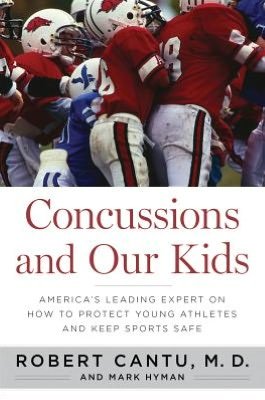 Sports concussion injuries are far more common than we like to believe. There are about 300,000 suffered every year by high school athletes, and more than 80% come from playing football. These concussions are often described as mild brain trauma. However, there is nothing mild about a sport-induced concussion if the side effects of it continue for months after the injury.
Sports concussion injuries are far more common than we like to believe. There are about 300,000 suffered every year by high school athletes, and more than 80% come from playing football. These concussions are often described as mild brain trauma. However, there is nothing mild about a sport-induced concussion if the side effects of it continue for months after the injury.
There is really no effective current treatment for sports concussions other than rest. But what if you are already competing in a sport that continues to put yourself back into harm’s way. Most likely you will get another concussion in the not so distant future, and hopefully it, too, will go away with rest. This is like playing Russian roulette because eventually you will end up with enough accumulated brain trauma that your future prospects for a quality life after playing sports becomes diminished.
The reason there is no effective treatment of concussions is that we don’t know much about what actually happens during the brain trauma induced by the concussion. When we break an arm, the doctor can immobilize it so it can heal. During this process there will usually be some pain that can be relieved by taking an anti-inflammatory drug. A concussion is not all that different. Just like breaking a bone, in a concussion nerves are also broken (snapped to be more correct), and there is the resulting inflammation-induced side effects. These could include light sensitivity, anxiety, lack of coordination, depression, loss of mental focus, inability to control emotions, etc. However, in lingering mild brain trauma these symptoms are simply the ongoing inflammation inside the brain. The type of inflammation that causes these side effects of the concussion is not the type you can directly feel, but a far more insidious type that is below the threshold of pain. I call this cellular inflammation. Without relieving this type of cellular inflammation, the side effects of concussions will continue to linger for months, if not years, and frankly for many may never be overcome. The reason is, the brain is on fire. Unless you put that fire out, the brain is not going to repair itself.
There is no drug that can effectively reduce cellular inflammation, however, it can be the reduced by high-dose fish oil. The reason that high-dose fish oil is important is that it is rich in anti-inflammatory omega-3 fatty acids that can enter into the brain. The question is which omega-3 fatty acids in fish oil have the greatest anti-inflammatory properties and how much do you need to have a positive benefit on reducing the cellular inflammation induced during a concussion?
Before I get to that answer, let’s talk about the fatty acid that causes inflammation in the first place. This is the omega-6 fatty acid known as arachidonic acid. It is relatively rich in the brain, but usually in a storage form that is only released upon injury. Once arachidonic acid is released, it is made into powerful inflammatory hormones called eicosanoids. These are the hormones that cause inflammation. The brain can’t make arachidonic acid, but it can easily accumulate it from the blood. Ultimately, the levels of arachidonic acid in the brain are determined by your diet. And a diet rich in omega-6 fatty acids (coming from vegetable oils like corn, soy, sunflower, and safflower, which are great sources), especially one that is rich in refined carbohydrates (that cause increased insulin levels) is sure-fire way to ensure you have a lot of arachidonic acid (AA) in the brain.
Now we can get back to the question of omega-3 fatty acids. Fish oil contains two: One is called eicosapentaenoic acid or EPA and the other is docosahexaenoic acid or DHA. For a long time it was assumed by neurologists that since there is very little EPA in the brain, it is not very important for brain function. Recent data indicate this is totally false. EPA and DHA both enter into the brain at the same rate. DHA gets shunted off for long-term storage, while the EPA is rapidly oxidized to carbon dioxide and water. That would seem to be a rather useless waste of a very valuable fatty acid. But nature is rarely inefficient. Rapidly oxidizing the incoming EPA provides a unique mechanism to control levels of cellular inflammation in the brain. You only need EPA in high levels in the brain to reduce inflammation (EPA is about 10 times more effective in this regard than is DHA based on animal studies and heart disease studies in humans). That is the case if large amounts of AA are being released as a consequence of the cellular inflammation caused by brain trauma. If the EPA is present in sufficient amounts in the brain, then the resulting AA/EPA ratio in the brain will remain low and so will cellular inflammation. If there is not enough EPA in the brain, AA released during brain trauma will run amok accelerating the inflammatory damage that results in the various side effects associated with long-term brain trauma. So if you want to put out the fire in the brain, you’d better have a lot of EPA in the blood so that adequate levels can reach the brain to put out the fire if it starts to burn.
This is why the AA/EPA ratio in the blood is your best indication of what the current levels of cellular inflammation are in the brain. If the AA/EPA ratio is high in the blood, then the brain has virtually no reserve to protect itself from the inflammation induced by any type of concussion. On the other hand, if you maintain a low AA/EPA ratio in the blood, your chances of reducing the consequences of brain trauma should be greatly increased. If you have continuing symptoms of mild brain trauma, then until you reduce the AA/EPA ratio in the blood, the cellular inflammation in the brain will continue to drive those symptoms. This is not a standard blood test, but it one that we do routinely in our laboratory for research and clinical studies.
I demonstrated this in an animal study that was published in the January 2011 issue of the Journal of Neurosurgery. In this study, mice were given a concussion injury and then given ihttps://ng doses of fish oil high in EPA. At the highest dose of EPA, the neural damage induced by the concussion was reduced by 98 percent. The reduction in nerve damage was correlated with the decrease in the AA/EPA ratio in the blood. Fairly impressive results in animals, but does it work in humans?
The answer appears to be yes. I make that rather definitive statement based on events that started more than five years ago with the Sago mine disaster when 13 miners were trapped in a cave-in in West Virginia. When the rescue team finally broke through, only one miner was still alive, but just barely. He had heart failure, liver failure, kidney failure, and brain failure. In fact, the MRI of his brain showed that virtually all the white matter was destroyed. If there was ever an ultimate case of severe brain trauma, this was it. His neurosurgeon called me that night the miner was rescued and asked my advice on what would be the best course of action. I recommended immediate dosing with high-dose fish oil rich in EPA through the patient’s feeding tube. Since there was no drug known that could reverse the inflammation, there weren’t too many alternatives. I immediately shipped overnight several bottles of our liquid fish oil so it could be delivered through the surviving miner’s feeding tube. The protocol was 15 grams of EPA and DHA per day, and we measured his AA/EPA ratio in the blood on a weekly basis. This was continued for two months until he came out of his coma and the same protocol was continued for another two months while he was in rehab.
Four months after the mine collapse, the surviving miner went home with a normal heart, kidneys, and liver and gave a press conference worthy of a politician. The media said it was miracle. In reality, it was aggressive use of fish oil rich in EPA to put out the fire in the brain. Maybe it was a lucky break. But the same protocol has been subsequently used successfully in six out of six patients with severe brain trauma. More recently we have used a similar protocol to rebuild the brains of several retired NFL players and other professional athletes with significant brain damage caused by continuous concussions incurred while continuing to play. And if high-dose fish oil rich in EPA can rebuild severely damaged brains, then doesn’t it make sense that taking fish oil rich in EPA will protect a brain when it is exposed to trauma. The brain is the most important organ in the body so you want to protect it. That’s why your grandmother always told your parents to take their fish oil. Just make sure it is rich in EPA.
Dr. Barry Sears is one the world’s leading authorities on the effect of food on hormonal responses and cellular inflammation. He is the author of the #1 New York Times best seller, “The Zone.” His books have sold more than 5 million copies, and he has published more than 30 scientific articles. He is also the President of the non-profit Inflammation Research Foundation.






























